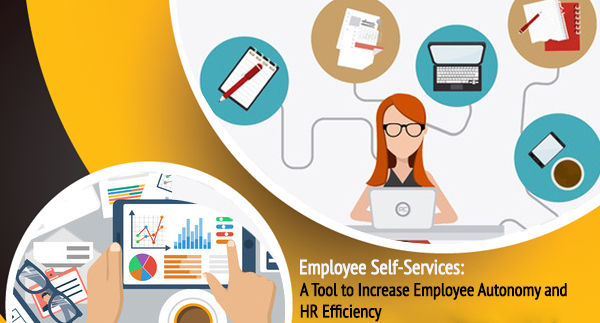According to a Hunter Group’s Human Resources Self Service survey, more than 90 percent of 342 companies surveyed are ”successful or somewhat successful” in employee self-service implementations. The survey shows that the number of companies using web-based self-services will increase from 46% to 82%, a striking statistic for sure. On an average, a company would spend $1.5 million on self-services solution, depending upon the size of the organization and the type of solution implemented.

The Wave of Employee Self-Services is Raging
The term “Employee Self-Services” must have echoed at least once in every Human Resource department. That’s the impact of technology on human resource management. Employee self-service (ESS) refers to a technology solution which allows employees to access their personal information and conduct vast array of people-related transactions through a centralized gateway or online website.
HR departments managing on-paper transactions and employee files spend as much as 65% of their time on administrative work, thus becoming a tedious and time-consuming task. ESS aims to give ownership to employees for managing their own data, cut down paperwork and expense, and reduce burden from HR team.
A Towers Watson report named New Horizons, No Boundaries stated that as organizations are rapidly deploying self-service technology, employees and line managers are becoming more interested in these capabilities and the ability to access & control their own data. Hassle-free ESS positively impact employee satisfaction level, and this becomes a key to success for engagement initiatives taken by an employer.
Here are a few reasons that have improved self-service software adoption rates and given more time to HR to focus on core processes.
- Cut Down Queries
An ESS tool provides answers to frequently asked questions and offer employees a convenient way to apply and approve leave, check leave balances, update personal data, complete benefits and enrollment forms, get approval on travel expense from managers, access the employee directory, view organizational hierarchy, to name a few functions. Employees feel satisfied using customized, user-friendly ESS tool as they can instantly access and process any personal information online, in just a few clicks.
- Save Company Costs
Using a self-service technology solution significantly reduces costs that is spent on paper forms and files. The need to hire a huge HR team to manage employee-related processes and administrative work can also be eliminated.
- Speed Up Decision Making
Employees remain informed when their data is made accessible to them. For instance, they can check their leave balance before applying for a leave request to the manager. Employees can access their benefits and enrollment information anytime and modify it according to their preferences.
Mass surveys can be conducted, and employees’ opinions can be gathered through a self-service portal. The leadership can make decisions by analyzing employee opinions. This simplifies decision making and increases employee engagement.
- Simplify Communication
Harness the opportunity to communicate updates on benefits plan, health plan, company holidays and more. Self-service technology simplifies company-wide communication and keep all stakeholders updated on any changes in HR policies.
An ESS tool can keep new hires informed about company policies and workplace rules. New hires can access company directory to know basic details about their colleagues. They may even check Organizational Chart to identify company hierarchy structure.
- Empower Employees
Just like online banking allows customers to manage their transactions and money from any part of the world, you too can empower your employees by giving them high level of control, access and responsibility to efficiently manage and modify their personal and performance data. Online employee self-services give autonomy, sense of accountability and ownership to employees, which increases their satisfaction and engagement. A report by Aberdeen Group shows that Employee Self Service software helps in increasing employee engagement by 18%.
Though there are many HR vendors offering these solutions, yet experts suggest choosing a software provider that specializes in employee self-service technology. Empxtrack is a leading ESS solution provider that serves in more than 20 countries and is well-known for offering user-friendly self-service portals to ensure compliance and save costs. Since ESS technology has a great impact on employee engagement, do not risk and choose the software wisely.


